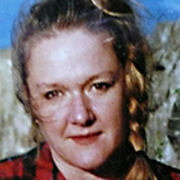
Mairi Gunn
When Mairi Gunn began working on film sets in the 80s, women were a rarity in the camera department. Though Kiwi Ramai Hayward had been a pioneer female camerawoman back in the 1940s (initially overseas), Hayward remained a rarity in the traditionally male-dominated world of cinematography.
After completing a Bachelor of Science degree at Auckland University, Mairi Gunn began taking photos for Rip It Up and student mag Craccum. Covering the police occupation of Bastion Point in 1978, Gunn spied Merata Mita filming proceedings from the back of a truck, and was inspired by her example.
During her OE Gunn studied photo-journalism at London College of Printing, and helped out in the editing rooms of a production company. After returning down under in 1983 she worked in the cutting room on a number of features for local company Mirage, including Came a Hot Friday and Pallet on the Floor. Then she got the chance to join Leon Narbey as an unpaid camera trainee on short film The Secret.
By now she was working as a clapper loader or focus puller on short films, music videos and a multitude of TV dramas. By the early 90s Gunn had begun commanding the camera on a run of productions short and long — including the 70-minute Sheilas: 28 years On, early Harold (The Map Reader) Brodie feature Reality Show, and a personal favourite, her award-winning video for The 3D’s 'Outer Space'.
In 1993 Merata Mita called on Gunn to help film documentary The Shooting of Dominick Kaiwhata. The following year she was director of photography on the feature-length Gravity and Grace, directed by American Chris Kraus, who partly grew up in New Zealand. Shot in Auckland and New York, the film explores ideas of faith and parallel lives. Gunn also values having worked with several women artists who sadly passed away early in their creative lives: Shirley Grace (doco To Erin’s Exiled Daughters) Sally Smith (Timetrap), and artist Sharon Alston.
Gunn’s CV of short films also includes a number made with director Simon Marler. In 2007 she and Marler joined musician Karen Browne and many Northland locals to make doco Restoring the Mauri of Lake Omapere. The 70 minute labour of love chronicles efforts to repair a Northland lake — a taonga to Ngāpuhi people — which had been made toxic by pollution. Gunn was both director of photography, and co-produced; as she writes here, the film made her look at life with new eyes. Lake Omapere won best film at the 2008 Wairoa Māori Film Festival.
That year she directed her own short Glory Box — the tale of a young Pākehā of Scottish descent who leaves the city to build a cairn, in memory of her old people. While humming a Gaelic air, she hears and follows a karanga that acknowledges her ancestors, and provides a welcome to her new homeland.
Gunn has lectured and taken workshops on filmmaking at a number of tertiary institutions and art schools. She has also launched the Slow Film Movement, based on the concept of making films at a more measured pace, free from the risk of never seeing one's friends or family.
Profile updated on 28 October 2019
Sources include
Mairi Gunn"
Mairi Gunn, 'Women in camera - things are looking up' New Zealand Cinematographers Society website. Loaded 26 January 2016. Accessed 28 October 2019
'Mairi Gunn' Colab website. Accessed 10 May 2012
Deborah Shepard, reframing Women - A history of New Zealand film (Auckland: HarperCollinsPublishers, 2000)